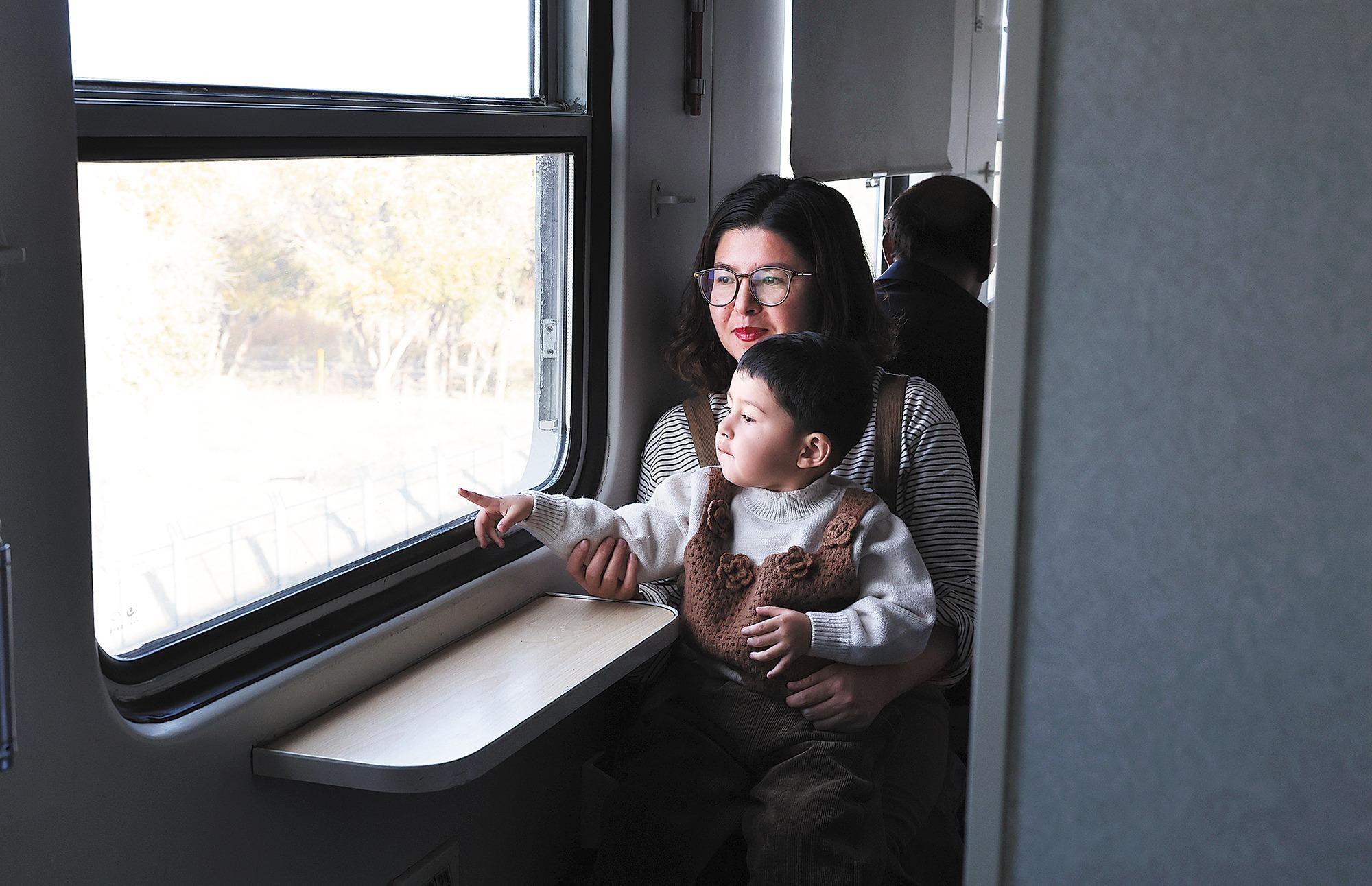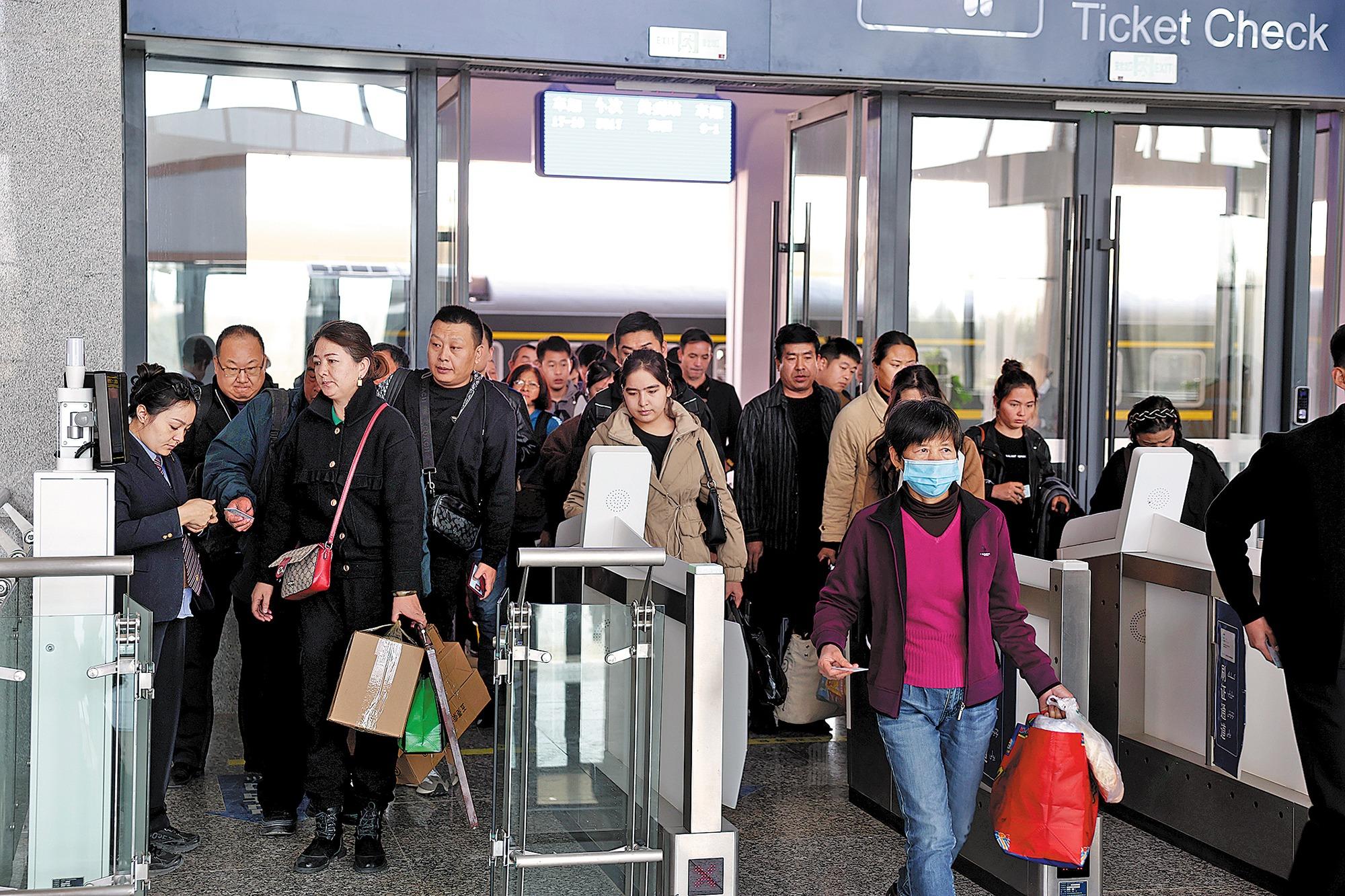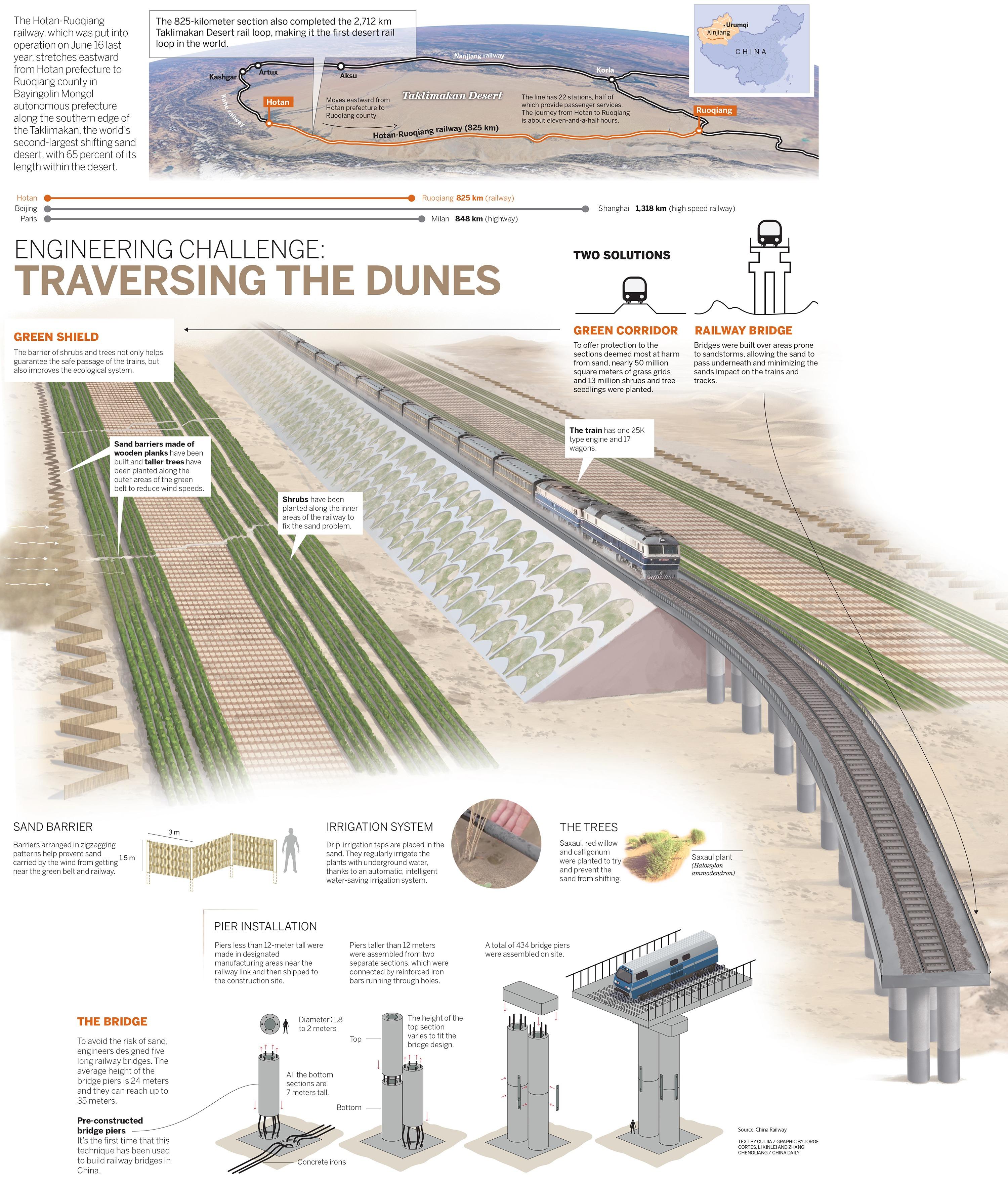Editor's note: Improved infrastructure, policy support and funding in areas with large populations of different ethnic groups have transformed people's lives. China Daily presents a series of stories about how China is determined to leave no ethnic group behind in the country's development, while inspiring them to embark on a new journey and make achievements in the new era. This article is the first installment, focusing on transportation in Xinjiang. It is also the ninth installment in a series of visual stories that highlight the important points on China's path to modernization.
 Gulbar Herem and her child take the train to Qira county, Xinjiang Uygur autonomous region. (FENG YONGBIN / CHINA DAILY)
Gulbar Herem and her child take the train to Qira county, Xinjiang Uygur autonomous region. (FENG YONGBIN / CHINA DAILY)
Gulbar Herem enjoyed sitting by the window while taking the train back to her home in Qira county, Hotan prefecture, because she found the passing view of huge sand dunes breathtaking and surreal.
Outside the window, the Taklimakan Desert in the Xinjiang Uygur autonomous region flashed by as the train made its way along the railway tracks.
"We are actually traveling through the desert that is literally called 'the place with no return'. I still cannot believe it's even possible," Gulbar said, while taking her cellphone out to capture the moment the train passed a stretch of poplar trees brightening the desert with their golden leaves and creating a picturesque autumn landscape against the blue sky.
It was only when a crew member of the 5817 train service operating from the regional capital of Urumqi to Hotan reminded her that the train would soon arrive at her destination, that she realized the Qira people's dream of having a train service at their doorstep was now a reality. Their lives immediately changed when the railway opened on June 16, 2022.
The Hotan-Ruoqiang railway stretches eastward from Hotan to Ruoqiang county in the Bayingolin Mongol autonomous prefecture along the southern edge of the Taklimakan, the world's second-largest shifting sand desert. About 65 percent of the railway is within the desert.
The 825-kilometer section also completed the 2,712-km-long Taklimakan Desert rail loop, making it the first desert rail loop in the world.
The opening of the line, which is a key national railway project, brought train services to five counties — Qira, Lop, Yutian, Minfeng and Qiemo in southern Xinjiang — and shortened the travel time for locals.
Before the new railway opened, to get to Urumqi from Hotan people had to use the train service that travels along the northern edge of the Taklimakan and takes about 34 hours.
Now, they don't need to make such lengthy detours. With a designated speed of 120 km per hour, the traveling time has been cut by about 10 hours. For Gulbar, a schoolteacher, her journey to Qira only took about 20 hours.
"The Hotan-Ruoqiang railway has been the talk of the town since its construction started in December 2018. And people including me have been closely following the progress of the news. Now, it has become an important part of our lives," she said.
Wider horizons
As Gulbar got off the train at Qira, more people got on, and the train was soon packed again. Many people were wearing colorful traditional Uygur customs and carrying naan bread and roasted mutton. The aroma of the food quickly filled the train car.
A lot of the travelers told train conductor Zhao Hong, who was busily helping them find their seats, that they were taking the train to visit relatives in another county.
More and more people have started to take short train trips to other counties because it's convenient and cheap, Zhao said. "We didn't expect to see the new service be this popular. Many people are taking the train for the first time in their lives as train services have just become available in their home counties. You can see the excitement in their eyes," she said. "They even bring us gifts such as walnuts and mutton to show how happy they are about the new railway that they've always wanted."
Akbar Turson, a passenger from Lop aged in his 40s, said the new line has cut travel costs for locals and made the journey much safer.
Before the train service became available in Lop, people often chose to take a long-distance bus to Urumqi, which cost about 500 ($70) to 600 yuan. The cheapest train ticket is only about 170 yuan and, Akbar said, people no longer need to worry about road accidents.
"Now, people in Lop can easily travel elsewhere by train to find new opportunities or just go sightseeing in other places. In fact, the new line isn't only about adding a way of traveling, it has made people, especially young people, see China's determination to develop Xinjiang," Akbar said.
Abdulret Abdulhabar, also from Lop, took the train back home after visiting Urumqi for the first time. "I finally decided to travel to Urumqi with my friends because the new train service is fast and comfortable," the 21-year-old said. "I'd love to travel more in the future because I can see more new things."
 Passengers have their tickets checked as they walk out of the Qiemo station in Xinjiang. (FENG YONGBIN / CHINA DAILY)
Passengers have their tickets checked as they walk out of the Qiemo station in Xinjiang. (FENG YONGBIN / CHINA DAILY)
Language access
Izak Memet joined the railway maintenance team at Qiemo station in December 2022. He said even people like his parents, who aren't fluent in standard Chinese, are confident enough to take the train because a Uygur-language service is available for ticket inquiries and on the train.
"My parents, who didn't like to travel before, have now become the train's loyal passengers. They often hop on the train to Korla city and Urumqi on a whim to meet their friends. It's hard to locate them these days," the 24-year-old shrugged and said.
As Abdulret got off the train at Lop station, he said he hoped more people would visit the county, which has much to offer including traditional Uygur cuisine and cultural heritage sites. "Getting to Lop has become easier than ever. I am sure people will have a good time there."
More travelers have already made trips to the five counties after they were connected by China's railway network.
"It's obvious that more people, including tourists, came to Qiemo in the summer. And many of them came by train," Izak said at Qiemo station.
In the past, people could only reach Qiemo by road or air, and services were often suspended for days at a time because of sandstorms, Izak said. "In contrast, train services are very stable. There have been a few strong sandstorms since I got here, but no train service was canceled."
 Visitors enjoy traditional Uygur dance in Hotan, Xinjiang, after the opening of the railway facilitated the further development of local tourism. (FENG YONGBIN / CHINA DAILY)
Visitors enjoy traditional Uygur dance in Hotan, Xinjiang, after the opening of the railway facilitated the further development of local tourism. (FENG YONGBIN / CHINA DAILY)
Desert attractions
Izak added that he's surprised to see how popular the Hotan-Ruoqiang railway is with tourists. "Many of them just come to see what it feels like to travel through the Taklimakan on a moving train, after many people shared their experiences on social media," he said.
A tourist from Guangdong province surnamed Zhang said he made local friends on the train while traveling from Ruoqiang to Yutian. "I may have skipped Yutian if the train service wasn't available there. In fact, my plan is to travel around southern Xinjiang by rail because the Taklimakan rail loop has been completed."
Zhang said he didn't expect the train to be full, but it gave him opportunities to connect with the locals during his eight-hour journey.
"They are so friendly. And I've learned to speak some basic Uygur language from them. I believe I can order lamb skewers in fluent Uygur from now on," he said.
According to China Railway Urumqi Group, one year after the Hotan-Ruoqiang railway was put into service, more than 360,900 passengers have traveled on it.
Deng Yujue, deputy manager of Hotan station, said the station has become more crowded, especially during traditional Uygur festivals.
"It's a good thing because it's proved that the new railway has been greatly welcomed by the local people and tourists," Deng said. "As the majority of passengers onboard the trains on the Hotan-Ruoqiang railway are local people from the Uygur ethnic group, we've stepped up the Uygur-language service to provide better guidance," he added.
 (CUI JIA / JORGE CORTES / LI XINLEI / ZHANG CHENGLIANG / CHINA DAILY)
(CUI JIA / JORGE CORTES / LI XINLEI / ZHANG CHENGLIANG / CHINA DAILY)
Economic benefits
Besides making traveling on the southern edge of the Taklimakan more convenient, the Hotan-Ruoqiang railway has also boosted the efficiency of logistic services and put local economic development on the fast track.
According to the China Railway Urumqi Group, as of mid-June, nearly 900,000 metric tons of goods had been delivered by freight trains via the new railway. By linking with the railway between Ruoqiang and Golmud, Qinghai province, the Hotan-Ruoqiang railway has also created another freight route connecting southern Xinjiang with other parts of China.
Gao Mingli, manager of the freight service at Hotan station, said the new railway has greatly boosted the efficiency of shipping goods from other parts of the country to Hotan.
"In the past, all freight trains to Hotan had to travel on the southern edge of the Taklimakan. As the route is busy, there are often delays that create uncertainty in the trains' arrival times," said Gao, while inspecting a train that had just arrived at the freight service center carrying chemical fertilizers and photovoltaic panels.
Now, freight trains can be diverted to the Hotan-Ruoqiang railway to get to Hotan, which is a shorter trip that helps prevent delays. It's extremely important for businesses, Gao added.
Huang Can, manager of Yihao Lingtong Logistics Company said since the new railway was opened, goods have arrived sooner. "We normally handle goods dispatched from Hubei province. In the past, it could take up to 12 days for the train to arrive. Now, it only takes eight days at most," Huang said.
Gao has also been working closely with local businesses to ship their products. "New freight service stations have been built along the new railway. And the local businesses all want to use them to ship local specialties such as walnuts and jam out via trains. I am sure more business opportunities will be brought by the railway in the future," he said.
Dream service
Luo Jie, who works in the financial sector in Beijing, took a selfie on the platform after train service 5817 arrived at Hotan station. He placed a journey on the Hotan-Ruoqiang railway on his Xinjiang must-do list after seeing a documentary about the efforts put into building the last section of the Taklimakan rail loop, which was played on a screen on the high-speed train from Shanghai to Beijing, he said.
"Waking up in the sleeping berth, I am astounded to find the train making its way through the Taklimakan. The sand dunes on both sides are like waves in the ocean, and it almost feels like I am traveling on a ship," Luo said.
He added that besides enjoying the unique views, he also talked to some local people on the train, and they all said that the railway had brought hope and prosperity to the southern edge of the Taklimakan.
"I suddenly realize that although the top speed of the train on the Hotan-Ruoqiang railway is only about a third of the high-speed train from Shanghai to Beijing, they are equally remarkable," Luo said.


